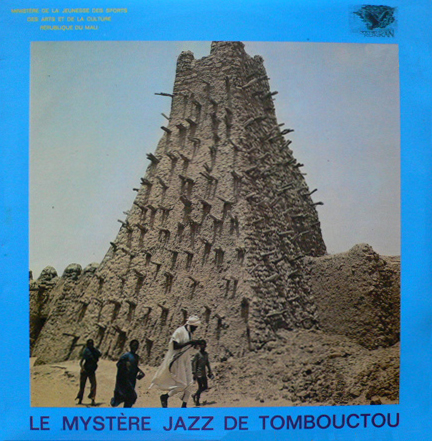African classics: Le Mystère Jazz de Tombouctou
Reviews of classic recordings from Africa

Mali Kunkan. KO 77.04.17. 1977
During the era of Mali's first
President, Modibo Keita (1960-1968), the government created
regional orchestras and arts troupes in each of the nation's
seven regions. These groups were state-sponsored and from 1962
they competed in annual arts festivals known as the "Semaines
Nationale de la Jeunesse" - or "National Youth Weeks". In 1968 a
military coup ousted President Keita and the new regime
abandoned most of his arts policies, though kept the "Semaines
Nationale de la Jeunesse" to appease the public, as the events
were very popular. The festivals were renamed as the "Biennale
Artistique et Culturelle de la Jeunesse" and were held every two
years. The first Biennale was held in 1970, and in that year the
prestigious recording label Barenreiter-Musicaphon released a
series of recordings of Malian musicians to celebrate the event.
Of the seven regional orchestras only recordings by the groups
from Bamako, Mopti, Sikasso, Ségou and Kayes were released on LP
by Barenreiter-Musicaphon - so what of the groups from Gao and
Tombouctou? Where were their LPs? The Orchestre Regional de Gao
later recorded three songs on the Malian government's Regard
sur le passé à travers le présent and Panorama du Mali
LPs, released in 1973, but the Orchestre Regional de Tombouctou,
also known as Le Mystère Jazz de Tombouctou, did not release a
recording until 1977, when the above LP was issued by the Mali
Kunkan label. It is perhaps the rarest release by Mali Kunkan,
and in my first trip to Mali in 1994 I endeavoured to find a
copy. I was staying in central Bamako at the Hotel du Niger, and
nearby was a little bar where I used to escape from the heat.
I'd bring in my cassettes of Malian orchestras and ask the bar
staff to play them. An older guy was interested in the music and
we chatted about Mystère Jazz and he told me that he could get a
cassette copy of their recordings. The next day he delivered me
cassettes not only of that group but also of the regional
orchestras of Gao, Sikasso, and the National Orchestra formation
"B", lead by Kassé Mady Diabaté. These rare recordings were
probable dubs from reel-to-reels stored in the sound archive at
Radio Mali. It is a sad fact that over many years the Radio Mali
archives have lost a lot of material, and some high profile West
African "producers" have been caught red-handed smuggling tapes
out of the country. The cassette copies I received were very
muddy in quality and over the years I cleaned them up as best as
possible.
Years went by and I never found
a copy of the Mystère Jazz LP. Recently, however I have been
given a CD copy and can review the tracks here. The opening song
of the LP is "Leli", and immediately launches into the big brass
sound and ostinato lead guitar which readily identify Mystère
Jazz's Malian style. The brass and guitar sections are teasers
for later solo passages - and what solos they are! Malian music
of this period is renown for the quality of the lead guitar
solos (e.g. National "A" Orchestra, Super Rail Band, Orchestre
Regional de Kayes, Super Djata Band, etc) and Mystère Jazz are
right up there with the best. The 2nd track - "Dina waliji" - is
a slow tempo number, and is in praise to Allah. Side A closes
with "Teiduma", and here the Touareg influence is strongly
evident. A great sax solo is also a highlight.
Side B opens with "Walé", a song
which draws attention to the sacrifices that women make in their
daily lives. The Touareg rhythms are again at the fore, somewhat
Gnawa-like, with a strong bass line and percussion styles that
imitate a qrakeb. "Tarekh" is the next song and is sung
in Tamashek. Here Mystère Jazz are at their peak: a drum and sax
intro the song and are then joined by the rhythm guitarist, who
creates an ostinato melody. The lead guitarist then swoops in to
join them and that announce the arrival of the brass section.
It's one of the best introductions to a Malian song that one is
likely to hear. During the song the lead guitarist continually
improvises with flourishes and runs, and the song builds in
tension until the arrival of a sax solo, which then segues into
the long awaited guitar solo. This explores several octaves and
closes with an exquisite melodic phrase. "Apolo" closes the LP,
and I'll write more on this song later.
Since that first cassette in
1994 I have come across other cassettes by the group. Though not
all can be certified as Mystère Jazz songs, for they were
bootlegs with no information written on them, I consider them to
be genuine recordings by the group. The vocalist is the
same, the lead guitarist, too, and it "feels" like the group.
Now here is a real mystery: I was sure that the cassette that I
was given in Bamako in 1994 was simply a dub of the Mali Kunkan
LP. In fact it isn't, and it appears to be from a studio session
recorded at the same time. Many tracks from the LP are present
but are definitely different versions, and are much better than
their LP counterparts in my opinion.
There are also completely new
songs. I don't usually upload songs to the internet, though on
this occasion given the rarity of the recording, the low sound
quality of it, and its magnificence, here it is -
an alternate version of "Tarekh". The guitar solo is
exceptional, the best, and it's one of all time favourite songs.
If you have this song in better quality please let me know!